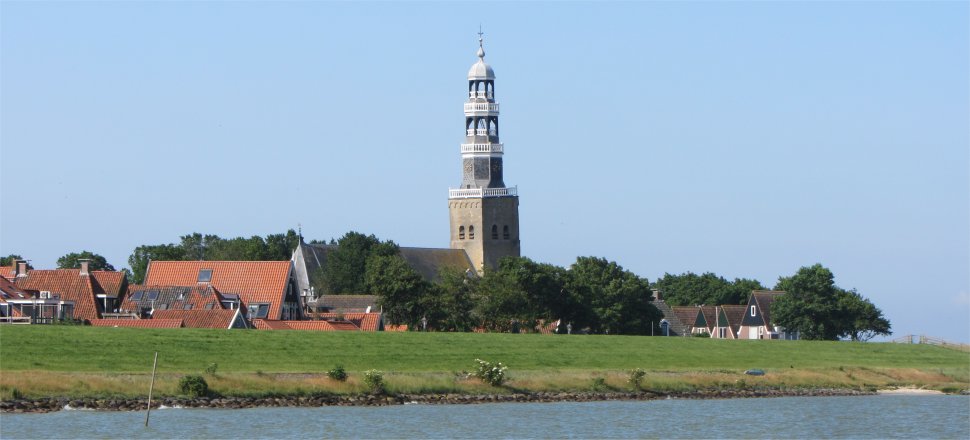 Farewell to the Leaning Tower of Hindeloopen |
The Afsluitdijk provides a road link between the provinces of Friesland and North Holland. About 4km from the coast of Friesland, Kornwerderzand stood on a former artificial island which was created during the construction of the dam. The settlement has a population of just over 20. It is part of the municipality of Wonseradeel. The shipping locks at Kornwerderzand, also known as the Lorentzsluizen (Lorentz Locks), provide access to the Waddenzee from the Ijsselmeer, and a complex of discharge sluices control the water level in the Ijsselmeer. A second complex of sluices and locks is located at the other side of the Afsluitdijk, near Den Oever.
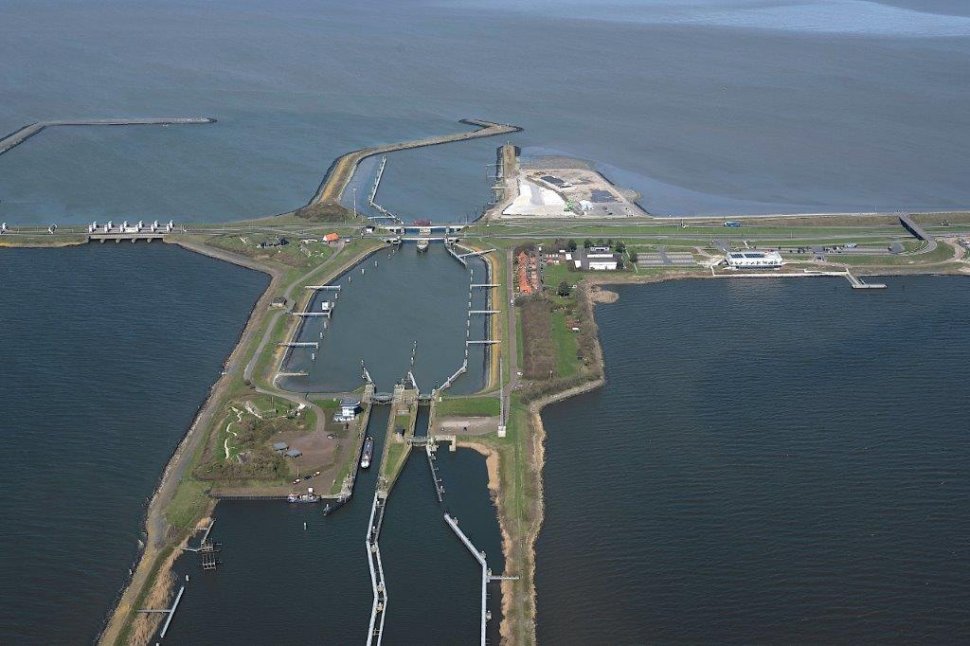 Kornwerderzand Sluis |
The region - whose core consists of the provinces of Friesland, Overijssel and Flevoland and the municipalities of Kampen, Meppel, Urk and Southwest Friesland - has therefore joined forces with the maritime business community and shippers to widen the lock complex at Kornwerderzand replace the bridges and deepen the navigation channels.
The project entails an important boost for the regional and national economy. It is expected to create some 3,000 new jobs in the north and east of the Netherlands.
Meanwhile, back at the lock, the lights had turned to red/green, and the usual chaos ensued, when all continental boats raced into the lock as quickly as possible in order to grab pole position.They are all extremely competitive, not laid back like Rex.
Once out of the lock and past the swing bridge, we followed the narrow channel up the eastern side of the Waddenzee, dodging the churn of fast yachts, barges and police RIBs. Harlingen started off as a smudge on the horizon, but soon came into focus.
We had been watching a Frisian Isle ferry enter Harlingen harbour not too long before we reached it. Our entry was painless with only a ferry boat to avoid. The ferry we had spotted was berthed by the ferry terminal; all we needed to do was pass it and make our way up to the Tsjerk Hiddessluizen. The lock derived its name from Tjerk Hiddesz de Vries, an admiral who was killed in 1666 during a sea battle against England. Just as we were approaching the ferry, it blasted out three toots from its horn. That meant "I am manoeuvring with my propulsion system in reverse"; in other words, "get out of the bloody way". We obliged and motored around in a large circle until the ferry was out of our way and we proceeded to the lock. A quick call to the lockkeeper from Rex in his fluent Dutch soon resulted in the lock gates opening for us, and we headed in and secured Duonita to the starboard side. Another boat joined us, manned solo by a young chap who moored his craft singlehanded expertly. He was a Fries and returning to Franeker.
After the lock we turned sharp right into the HSWV marina in the Noordergracht, a delightful little section of canal, quiet, lined with trees and some tasteful houses. At the eastern end of the marina, the pretty Franekerpoortbrug stood where centuries ago one of the town gates marked an entry point into the fortified town.
I went off in search of the harbour master: lunch break 12:00 - 14:00, we had 15 minutes to wait. Another boat pulled in.
"Waar is de havenmeester?" asked the skipper.
"Hij komt om 14.00 uur terug," I replied. He thanked me and returned to his boat to join the queue.
The harbour master did turn up on time, and after a little banter we were checked in for three nights. Rex needed a nap, so I took a hike into town, reflecting on this Dutch province that we adored and had visited several times.
From north-east to south-west Friesland there are many small and large lakes, which are connected to each other by way of canals, waterways and rivers. The total water area is more than 11,000 ha and it is all on the same level. So, you can sail without going through locks or sluices. Friesland is not just a land of lakes and water and extensive meadows. In Gaasterland between Miserly and Wijckel there is a large forest area with footpaths and openings onto meadows and fields. Traditional farms pepper the landscape, with their shiny black or terracotta red roof tiles, and fields often contain characteristic Frisian pedigree cattle or the elegant black Frisian horses. All of this, plus the most historic villages and towns, rendered Friesland a must visit region.
Harlingen is one of the original eleven cities of Friesland, connected by canals used in the long-distance ice-skating event called "Elfstedentocht." You can visit these cities on skates if the ice is thick enough in the winter. The town was founded in 1243 near the site of the town of Grayn, which was engulfed by the sea in 1134. The harbour of Harlingen, which was formerly a considerable trading town, still exports Frisian products and imports coal, timber and other industrial raw materials. In the harbour area are shipyards, fish-processing plants, woodworking factories and works producing building materials. From the town, ferries cross to the islands of Vlieland and Terschelling, and the harbour is linked with Leeuwarden by the Van Harinxmakanaal.
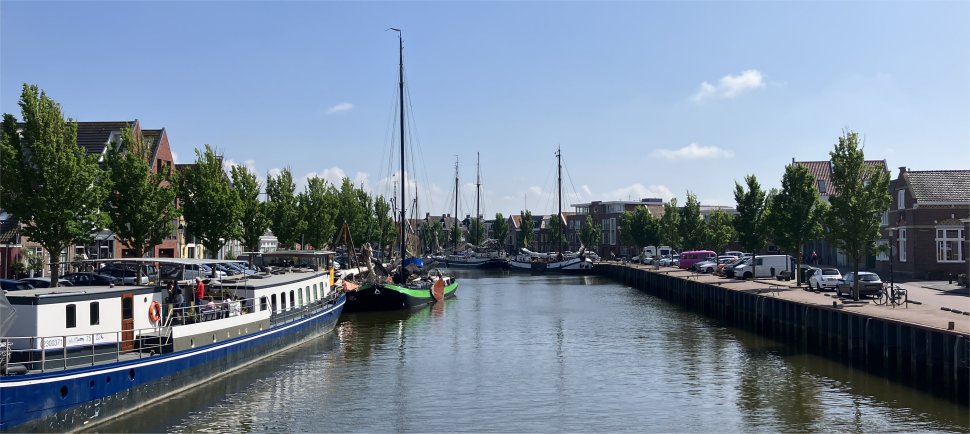 Zuiderhaven |
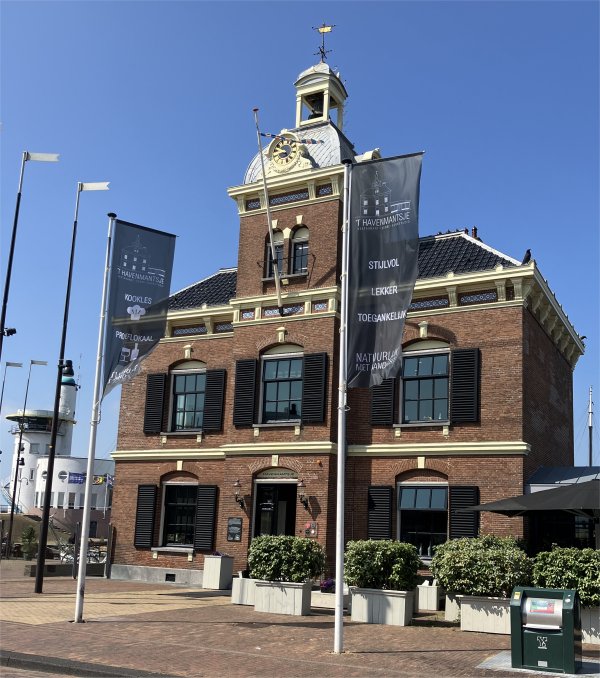 't Havenmantsje |
Famous Harlinger naval officers from the Frisian Admiralty era were Tjerk Hiddes de Vries and Auke Stelwerwerf. Both men were fatally injured on their ship during a sea battle. Tjerk Hiddes de Vries, who was in command of the Frisian fleet during the Second Anglo-Dutch War, had no fewer than forty ships under his wing. At that time, the fleet was at its strongest.
The Admiralty was ubiquitous in the city in the 17th century. Not only did they need meeting rooms, but warehouses, shelters for prisoners and accommodation for the maids were also essential. The Admiralty owned a warehouse on the Zuiderhaven, a building on the Noorderhaven and several warehouses near the Westerkerk.
I passed the Havenmantsje, a restaurant in a converted courthouse, on the way after the bridge. I was particularly keen to see if the replia of the ship sailed by Willem Barentsz, De Witte Swaen, or the White Swan, was still moored in Willemskade. In 2017 Rex and I came across a reconstruction of the ship being built in a nearby shelter following as closely as possible the construction methods of the late 16th century, and we continued to monitor progress of the work on subsequent trips to Harlingen. The construction was being carried out by a group of enthusiastic old men, using mainly Danish oak. There were no designs, so the men evolved a design through what they could glean from old paintings and drawings, remains of old vessels deliberately sunk when the polders were being created, a section of the original old ship discovered by Russia and currently on display in a Russian museum, and the Batavia at Lelystad. The story behind the ship is one of the most heroic in Dutch maritime history, inspired by ingenuity, boundless courage and almost superhuman perseverance.
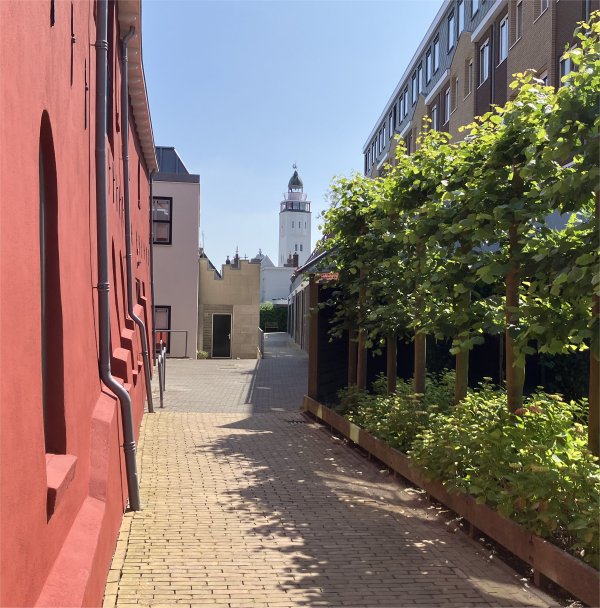 Peeping down to Harlingen Lighthouse |
In the late 16th century, the Dutch had an interest in the Orient, though at the time it seemed dangerous to contest the Portuguese monopoly of the route around the Cape of Good Hope. In 1595 Amsterdam merchants, undiscouraged by the English failure to find a Northeast Passage 40 years earlier, decided to resume the search. The Town Council of Amsterdam purchased and outfitted two small ships, captained by Jan Rijp and Jacob van Heemskerk, to search for the elusive channel under the command of Barentsz.
The ships departed on May 18th, 1596, and about three weeks later discovered Bear Island, south of the then-unknown Spitsbergen; they so named the island because of an encounter with a polar bear whose hide did not prove vulnerable to Dutch blunderbusses. Pressing northward, the Dutch ships came across the previously undiscovered uninhabited Spitsbergen islands on June 17th. During the rest of June, the Dutch explored the western coast of the main island, thinking it a part of Greenland.
The ships returned to Bear Island on 1st July. Here, anxieties over possible entrapment by ice resulted in a disagreement between Barentsz and Van Heemskerk on one side and Rijp on the other. They agreed to part ways, with Barentsz continuing northeast, while Rijp headed due north to resume exploration of Spitsbergen. Barentsz reached Novaya Zemlya on 17th July, previously discovered but not explored to its northern limit. Barentsz and Heemskerck rounded the northernmost point, naming it Hook of Desire, and sailed eastward, at first believing, from the open water encountered, that they had discovered the Northeast Passage. By November, however, the ice had grown thick and it finally imprisoned the ship. Barentsz and Heemskerck were 81�N at their highest latitude, beyond any point previously reached. Still close to Novaya Zemlya, they realised that they must build a solid shelter ashore in order to survive. They made one of logs and driftwood and moved into this 7.8 x 5.5m "Safe House" in October.
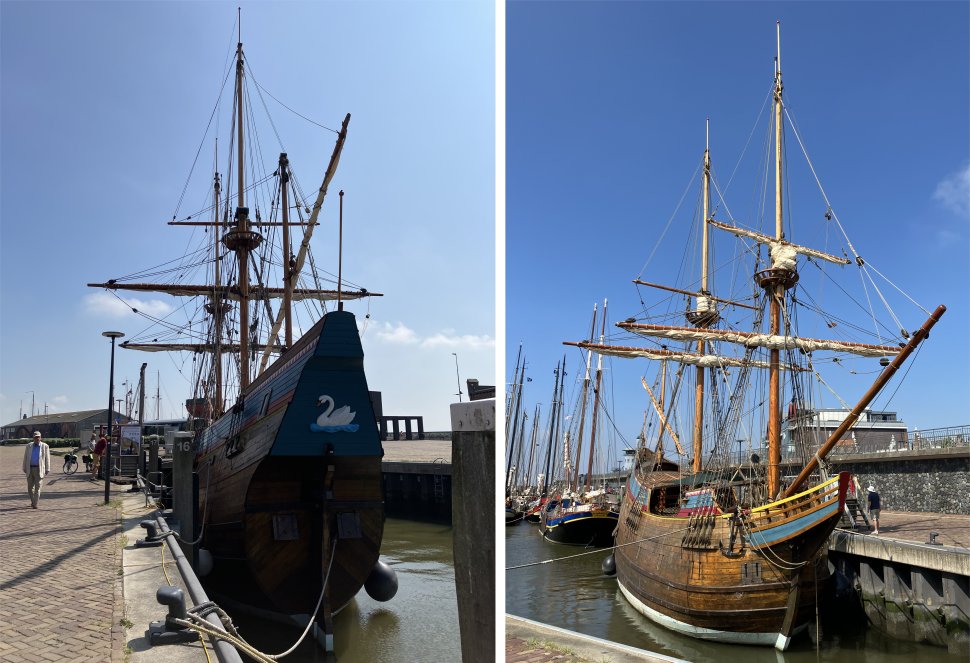 De Witte Swaen, or the White Swan |
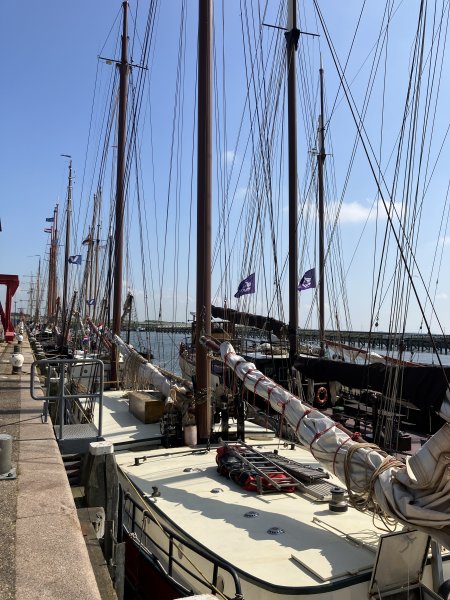 Tall Ships in Nieuwe Willemshaven |
Conditions then deteriorated; the firewood gave out, and the ship was crushed by ice. The men began to construct two small boats. Scurvy had been present for months, and one of the worst sufferers was Barentsz. He left on 13th June with the rest as they slowly worked down Novaya Zemlya, but he grew so weak that he could take no part in manipulating the craft. Barentsz died at sea on 20th June 1597, soon after asking Gerrit de Veer, chronicler of the expedition, to lift him up for a final look at Novaya Zemlya. Heemskerck and the other survivors reached the Kola Peninsula after seven more weeks, where they were rescued by a Russian merchant vessel, and by that time only 12 crewmen remained. They heard of a Dutch ship not far off, and a messenger was sent to ascertain whether it would rescue them. By pure coincidence the Dutch vessel was captained by Rijp, who had returned to Holland and come back for trade. Ultimately, they did not reach Amsterdam until 1st November.
In the 1870s European ships visited "Safe House" and found it partially caved in by snow. Objects left there by the Dutch explorers are in the Rijksmuseum in Amsterdam.
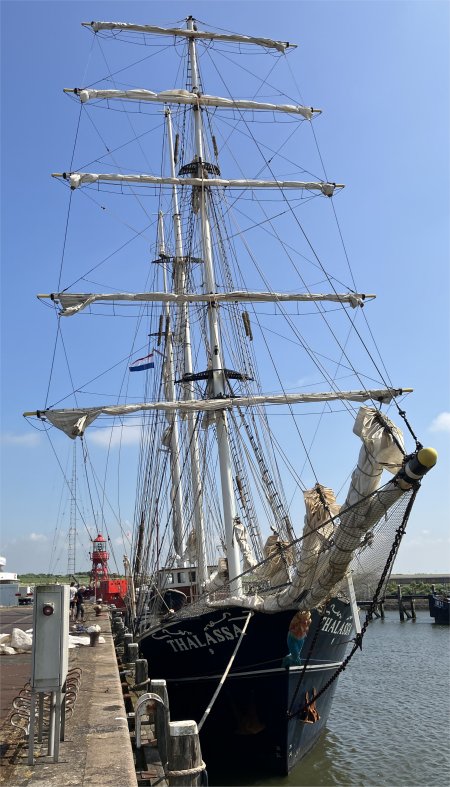 Thalassa |
I found the ship where it has been at the Willemskade for the last few years, and was pleased to see it completed as far as I could tell. Sadly, there was no information available to advise what the future plans were for the ship.
I walked across to Nieuwe Willemshaven, where a long line of tall ships was tied up. I smiled wryly at a couple of the vessels which had a mass of washed bed linen hanging up to dry. Further down was a four-masted vessel, the Thalhassa, which appeared to be receiving some TLC. A middle-aged man and an apprentice were gouging out rotten wood between the decking boards, some of it quite deep.
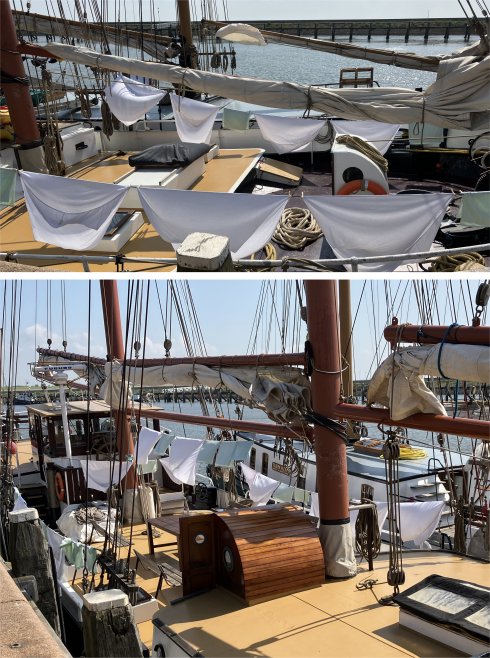 Washing Day |
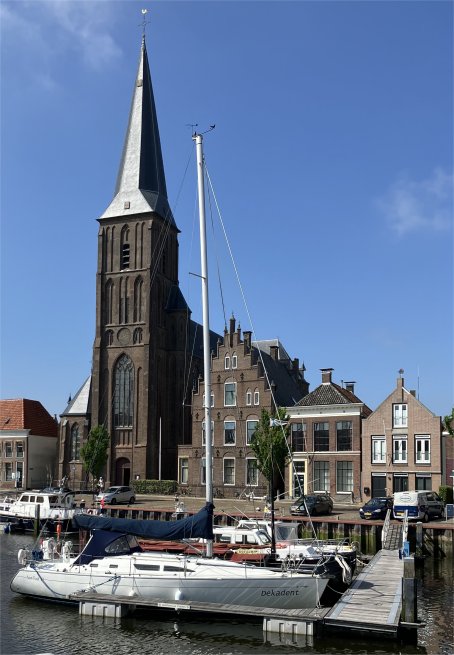 Sint Michaelkerk |
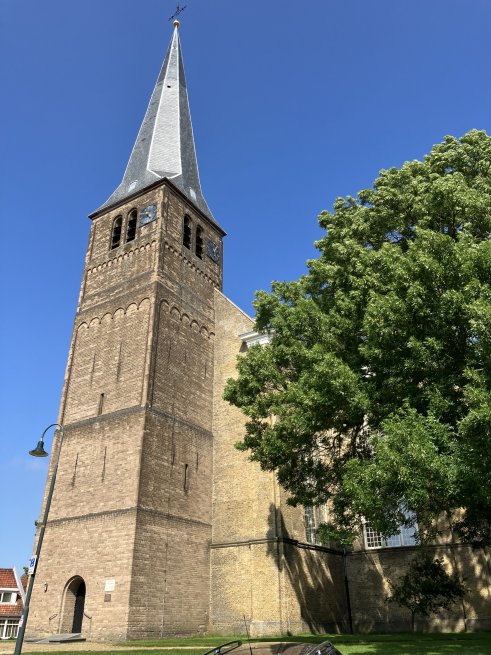 Grote Kerk |
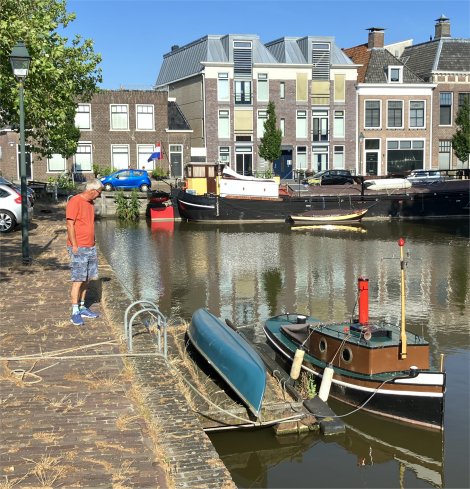 Rex always wanted a Tug |
A short walk further took me to the Grote Kerk. The present church was built on the site of a medieval church (Dom of Almenum) that stood on a mound. It was demolished in 1772 with the exception of the tuff church tower. The old pulpit (1604) was sold to the church of Ballum. The present cruciform church was inaugurated in 1775. The organ also dates from this year and was built by Albertus Antoni Hinsz. In 1864 changes were made to the organ by Petrus van Oeckelen. The instrument has two manuals and 36 stops, divided between main work, back positive and pedal. There is also a choir organ by Flentrop from 1980 with one manual, three stops and attached pedal. In the church is the tomb of Admiral Auke Stellingwerf and the tomb of Tjerk Hiddes de Vries."
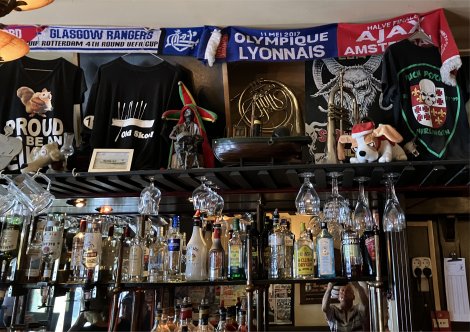 Bar in the Licht Boei |
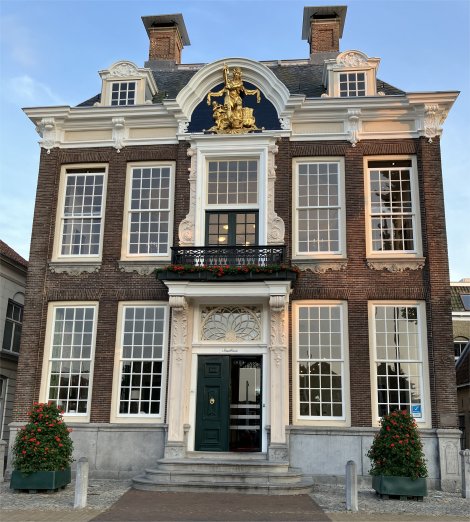 Stadhuis |
I was relieved to find Rex in a better fettle than he was earlier in the day, indeed he was ready to paint the town red. We started the painting at the Licht Boei, a favourite haunt of ours, a pub frequented by locals. Sadly, we learned they no longer sold beer on tap; it was all bottles. However, we did sample a couple of bottles.
Then we headed to Nooitgedacht (Never Thought), a restaurant that served excellent food which we had visited many times over the years. Indeed, the owner recognised us. The cuisine was still excellent; we did not return to Duonita hungry.
